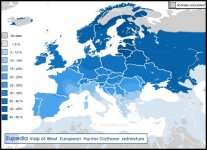Angela
Elite member
- Messages
- 21,823
- Reaction score
- 12,329
- Points
- 113
- Ethnic group
- Italian
I think you have to distinguish between potential height, which geneticists have traced to variations in autosomal dna, to expressed height, which can be affected by things like nutrition, hormones in food, the island effect, etc.
See: [h=1]GIANT study finds rare, but influential, genetic changes related to height[/h]
https://www.sciencedaily.com/releases/2017/02/170201131513.htm
"[h=2]International study of more than 750,000 people probes deeper into height than ever before[/h]Date:February 1, 2017Source:Boston Children's HospitalSummary:In the largest, deepest search to date, scientists uncovered 83 new DNA changes that affect human height. These changes are uncommon or rare, but they have potent effects, with some of them adjusting height by more than 2 cm (almost 8/10 of an inch). The 700,000-plus-person study also found several genes pointing to previously unknown biological pathways involved in skeletal growth."
""While our last study identified common height-related changes in the genome, this time we went for low-frequency and rare changes that directly alter proteins and tend to have stronger effects," says Joel Hirschhorn, MD, PhD, of Boston Children's Hospital and the Broad Institute of MIT and Harvard, chair of the GIANT Consortium and co-senior investigator on the study together with researchers at the Montreal Heart Institute, Queen Mary University, the University of Exeter, UK, and nearly 280 other research groups. "
[FONT="]"Using ExomeChip data from a total of 711,428 adults (an initial 460,000 people and about 250,000 more to validate the findings), the investigators identified 83 uncommon variants associated with adult height: 51 "low-frequency" variants (found in less than 5 percent of people) and 32 rare variants (found in less than 0.5 percent).[/FONT]
[FONT="]With these new findings, 27.4 percent of the heritability of height is now accounted for (up from 20 percent in earlier studies), with most heritability still explained by common variants."[/FONT]
See: [h=1]GIANT study finds rare, but influential, genetic changes related to height[/h]
https://www.sciencedaily.com/releases/2017/02/170201131513.htm
"[h=2]International study of more than 750,000 people probes deeper into height than ever before[/h]Date:February 1, 2017Source:Boston Children's HospitalSummary:In the largest, deepest search to date, scientists uncovered 83 new DNA changes that affect human height. These changes are uncommon or rare, but they have potent effects, with some of them adjusting height by more than 2 cm (almost 8/10 of an inch). The 700,000-plus-person study also found several genes pointing to previously unknown biological pathways involved in skeletal growth."
""While our last study identified common height-related changes in the genome, this time we went for low-frequency and rare changes that directly alter proteins and tend to have stronger effects," says Joel Hirschhorn, MD, PhD, of Boston Children's Hospital and the Broad Institute of MIT and Harvard, chair of the GIANT Consortium and co-senior investigator on the study together with researchers at the Montreal Heart Institute, Queen Mary University, the University of Exeter, UK, and nearly 280 other research groups. "
[FONT="]"Using ExomeChip data from a total of 711,428 adults (an initial 460,000 people and about 250,000 more to validate the findings), the investigators identified 83 uncommon variants associated with adult height: 51 "low-frequency" variants (found in less than 5 percent of people) and 32 rare variants (found in less than 0.5 percent).[/FONT]
[FONT="]With these new findings, 27.4 percent of the heritability of height is now accounted for (up from 20 percent in earlier studies), with most heritability still explained by common variants."[/FONT]


